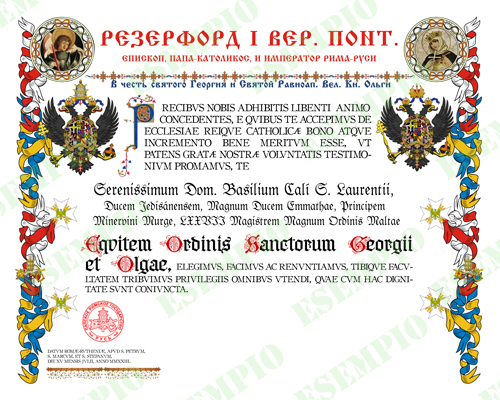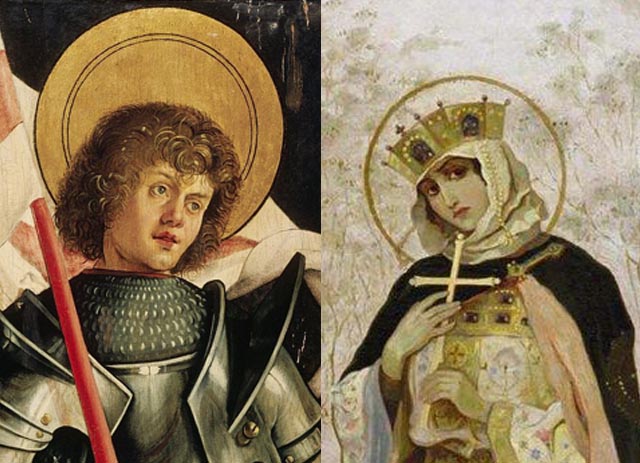|
Order of Saints George & Olga |
|
|||
|
The Order of Saints George and Olga is
a religious-dynastic order of the Pontifical Household of the United Roman-Ruthenian Church given to gentlemen and
ladies of high rank or office in recognition for significant service to
the mission of Rome or the Pontifical Household. The order is
subdivided into two divisions, one exclusively for gentlemen and the
other exclusively for ladies. The Grand Master of both
divisions is the Bishop of Rome-Ruthenia. The order is generally
only conferred upon nobles of the
rank of Baron and above and General officers and its civil
equivalent. It ranks
immediately after the Companions of the Pontifical Order of the Eagle. Membership also
confers nobility ad vitam.
Saint Olga was Grand Princess consort of Kiev and ruled the Old Russian State (Kievan Rus') as Regent on behalf of her son after her husband was assassinated. She is highly regarded for her efforts to spread the Catholic faith in her territory, which culminated in her grandson, Saint Vladimir the Great, making the Christian faith the official religion. She is also an ancestress of several royal and noble houses in Central and Western Europe, including the French Capetian and Bourbon dynasties.  St. Olga Equal-to-the-Apostles The order is given only in one rank, that of Knight or Dame. In rare and exceptional cases in recognition of the highest service, the office and distinction of Grand Commander may be conferred. Although the order ranks immediately after the Companions of the Pontifical Order of the Eagle, the honour of Grand Commander of Sts. George and Olga ranks first among dynastic honours and immediately after the Aquiline Order of Christ and Most Holy Pontifical Order of the Eagle. Also, Grand Dukes of Rome-Ruthenia receive this order, along with the Aquiline Order of Christ, on their 18th birthday. The insignia consists of a gold Roman Eagle centred upon a white eight-pointed cross with gold eagles in between. The cross is worn by Knights pendant from an orange and black striped neck ribbon, and by Dames pendant from a bow of the same ribbon. The Grand Master, Grand Dame (Apostolic Princess of Rome-Ruthenia), and Grand Commanders may wear the insignia on a broad ribbon sash in the colours of the order over the right shoulder. The colours are imperial yellow and black, with the yellow tinged with the red of the martyrs. Wear of Deocrations of the Pontifical and Imperial Orders
 Lapel Ribbon  List of Current Grand Commanders H.A.H. Prince-Bishop Radislav I, Roman-Ruthenian Pope H.A.H. Hanna Alexandrovna, Apostolic Princess of Rome-Ruthenia H.R.H. the Grand Prince of Epirus H.R.S.H. the Prince of Chíquiza
Nota
Bene: These orders are given exclusively by the United Roman-Ruthenian
Church, Stato Pontificio Imperiale di Roma-Ruthenia as historic orders
of the Stato
Pontificio. H.H. the Bishop of Rome-Ruthenia holds the exclusive right to
confer them.
|






